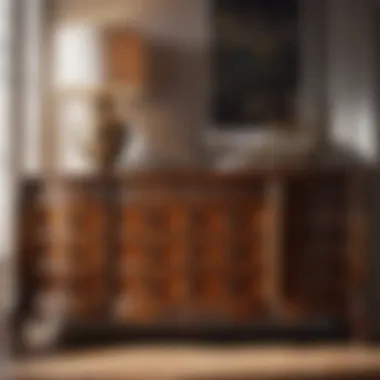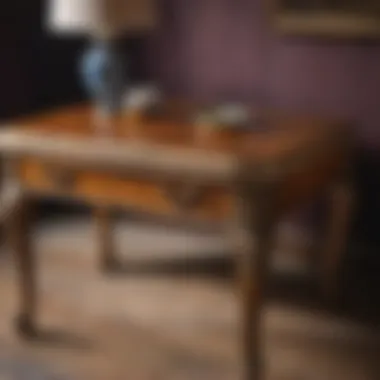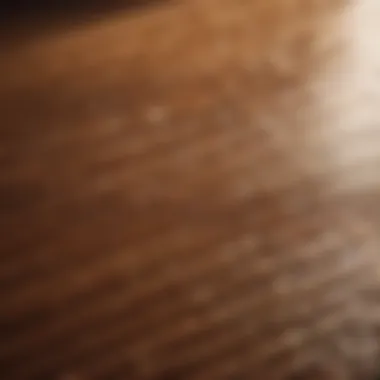Materials:
-
Protective Gear: Ensure safety by wearing gloves, safety goggles, and a mask to protect against fumes and chemicals.
-
Chemical Stripper: Select a quality chemical paint stripper suitable for the type of stain on your furniture.
-
Scrapers and Brushes: Utilize a paint scraper, wire brush, and fine steel wool to remove old stain effectively.
-
Sandpaper: Prepare sandpaper in various grits (coarse to fine) for smoothing the wood surface.
-
Clean Rags: Have clean, lint-free rags for wiping and applying stripper and finish.
-
Mineral Spirits: Use mineral spirits for cleanup and to help neutralize the stripper.
-
Wood Finish: Choose a high-quality wood finish like varnish or polyurethane for the final touch.
DIY Steps:
-
Prepare the Workspace: Start by setting up a well-ventilated area with a tarp or old newspapers to protect surfaces.
-
Remove Hardware: Take off any knobs, hinges, or other hardware from the furniture.
-
Apply Stripper: Using a brush or cloth, generously apply the chemical stripper following the manufacturer's instructions.
-
Scrape Off Stain: After the recommended time, scrape off the loosened stain with a scraper.
-
Repeat if Necessary: For stubborn spots, reapply the stripper and scrape again until all stain is removed.
-
Sand the Surface: Smooth the wood surface with sandpaper, gradually progressing from coarse to fine grits.
-
Clean the Wood: Wipe the wood with a clean rag dampened in mineral spirits to remove any residue.
-
Apply Finish: Finally, apply the chosen wood finish evenly for a protective and polished look.
Technical Aspects:
- Timing: Allow sufficient time for the stripper to work (typically 15-30 minutes) before scraping.
- Techniques: Work with the grain of the wood to prevent splintering or damage.
- Cleanup: Dispose of used rags and leftover chemicals responsibly to avoid hazards.
DIY Project Process:


- Installation Method: Follow the steps outlined above for each piece of furniture requiring restoration.
- Key Techniques: Ensure thorough application of stripper and even finishing strokes for a professional outcome.
Troubleshooting Tips:


- Stained Spots: If certain spots are hard to remove, cover them with a damp cloth to soften the stain before scraping.
- Uneven Finish: Apply additional coats of finish, sanding lightly between each coat, to achieve a smooth surface.
This meticulous guide equips you with all the necessary knowledge and tools to execute a successful furniture stripping project, transforming old pieces into revived treasures.
Introduction


In the realm of furniture restoration, the process of stripping furniture of stain holds a pivotal role in rejuvenating tired pieces and unlocking their hidden beauty. This essential stage sets the groundwork for a successful refinishing project, elevating both the aesthetic appeal and longevity of the furniture. Understanding the significance of stripping furniture of stain delves beyond mere surface treatment; it involves a meticulous approach that respects the integrity of the wood, enhances the overall visual allure, and serves as a crucial step in preparing a blank canvas for refinishing.
Preserving the Integrity of the Wood
Preservation of the natural beauty and structure of the wood is at the core of stripping furniture of stain. By removing old finishes and layers of stain, the true essence and character of the wood are revealed. This process not only protects the integrity of the furniture but also ensures its durability and longevity by addressing any underlying issues that may compromise its structural stability.
Enhancing Aesthetic Appeal
Beyond structural integrity, stripping furniture of stain plays a transformative role in enhancing its visual appeal. Unveiling the raw beauty of the wood allows for a fresh perspective on the furniture's design elements, grain patterns, and unique characteristics. Through the removal of old stains and blemishes, the furniture's inherent beauty is revitalized, offering a renewed sense of elegance and charm.
Creating a Blank Canvas for Refinishing
Moreover, stripping furniture of stain creates a pristine canvas for refinishing endeavors. By eliminating previous layers of stain, paint, or varnish, the furniture is reset to its original state, ready to be refinished according to personal preferences and creative vision. This blank slate not only provides endless possibilities for customization but also ensures that the refinishing process is executed on a foundation of purity and quality, resulting in a professional and polished final outcome.
Understanding the Importance of Stripping Furniture of Stain
In this comprehensive guide to stripping furniture of stain, we delve into the crucial reasons behind embarking on this meticulous process. Understanding the importance of removing old stains goes beyond mere aesthetics; it is about safeguarding the longevity and beauty of your furniture pieces. By stripping the old stain, you are essentially preserving the integrity of the wood, enhancing its natural features, and setting the stage for a successful refinishing endeavor. Moreover, stripping allows you to witness the true beauty of the wood beneath the old finish, breathing new life into your furniture.
Preserving the Integrity of the Wood
Preserving the integrity of the wood is paramount when it comes to furniture restoration. By stripping off the old stain, you are effectively removing layers of build-up and exposing the true essence of the wood. This process not only allows for a fresh start but also enables you to inspect the quality of the material, address any imperfections, and ensure that the wood remains strong and durable for years to come. By preserving the integrity of the wood through stripping, you are respecting the craftsmanship of the piece and honoring its natural beauty.
Enhancing Aesthetic Appeal
Enhancing the aesthetic appeal of your furniture is a key benefit of stripping off old stains. By revealing the raw beauty of the wood, you have the opportunity to create a visually stunning piece that reflects your personal style and taste. Whether you prefer a natural finish that highlights the wood grain or a painted look that complements your decor, stripping provides a blank canvas for you to express your creativity and elevate the overall aesthetic of your furniture. The process of stripping not only enhances the visual appeal but also adds character and charm to your piece, making it a focal point in any space.
Creating a Blank Canvas for Refinishing
Creating a blank canvas for refinishing is essential in achieving a professional-looking result. Once you strip off the old stain, you are left with a clean slate that allows you to apply new finishes and treatments with ease. This blank canvas enables you to experiment with different colors, textures, and techniques to transform your furniture into a personalized and refreshed masterpiece. By creating a blank canvas through stripping, you are revitalizing your furniture piece and giving it a renewed purpose and presence in your home.
Essential Tools and Materials
When it comes to the meticulous process of stripping furniture of stain, having the right tools and materials is paramount to achieving professional results. The essential tools and materials not only streamline the process but also ensure the safety and efficacy of the project. From safety gear to protective finishes, each element plays a crucial role in the restoration journey.
Safety Gear
Before embarking on the task of stripping furniture, it is imperative to prioritize safety. Safety gear such as goggles, gloves, and masks are essential to protect yourself from harmful chemicals and dust particles released during the stripping process. Ensuring proper ventilation in the workspace is also key to safeguarding your respiratory health.
Stripping Agents
Selecting the appropriate stripping agent is pivotal in effectively removing old stain from furniture surfaces. There are various types of stripping agents available, including chemical and citrus-based options. Consider the type of wood and the extent of the stain when choosing the most suitable stripping agent for the job.
Sandpaper and Scrapers
While stripping agents play a significant role in removing the initial layers of stain, sandpaper and scrapers aid in tackling stubborn remnants and achieving a smooth surface for refinishing. Different grits of sandpaper can be used to gradually sand down the wood and prepare it for a new finish. Scrapers help in removing excess stain and ensuring precision in detailing.
Protective Finishes
Once the furniture has been stripped of its old stain and prepared for refinishing, applying a protective finish is essential to enhance durability and aesthetics. Protective finishes like varnish, lacquer, or wax help seal the wood, prevent moisture damage, and bring out the natural beauty of the grain. Choosing the right protective finish is crucial in preserving the freshly restored furniture for years to come.
Step-by-Step Guide to Stripping Furniture of Stain
In this comprehensive guide, the step-by-step process of stripping furniture of stain plays a crucial role in achieving impeccable results. Each stage is meticulously crafted to ensure a seamless transition from old to new, breathing life back into tired furniture. This detailed guide provides essential insights, covering every aspect from initial preparation to the final touches, guaranteeing a successful restoration project.
Preparation
Remove Hardware and Upholstery
Removing hardware and upholstery is a fundamental step in the furniture stripping process. By taking apart these elements, you allow for better access to all surfaces, ensuring a thorough restoration process. This technique is favored for its ability to expose hidden areas that may require special attention, ultimately leading to a more refined end result.
Ventilate the Workspace
Ventilating the workspace is paramount during furniture restoration. Proper ventilation helps maintain a healthy work environment by dissipating potentially harmful fumes from stripping agents. This essential step ensures the safety of the individual carrying out the project and the longevity of the furniture being restored, making it a critical consideration for anyone engaged in this task.
Application of Stripping Agent
Testing on a Small Area
Before applying stripping agents to the entire surface, it is essential to conduct a test on a small, inconspicuous area. This preliminary test helps determine the compatibility of the stripping agent with the wood, ensuring that the finish will be successfully removed without causing damage. By starting small, you mitigate the risk of any adverse reactions and can proceed confidently with the full application.
Applying Evenly with Brushes or Cloth
Uniform application of stripping agents is key to achieving consistent results. Using brushes or cloths allows for precise coverage, ensuring that the stripping agent penetrates evenly across the surface. This method not only accelerates the stripping process but also minimizes inconsistencies, setting the stage for a seamless restoration journey.
Stripping Process
Scraping Off the Old Finish
Scraping off the old finish is a meticulous task that involves removing layers of stain and varnish accumulated over time. This process exposes the raw wood underneath, preparing it for further treatment. The careful scraping technique employed in this step is vital in preserving the integrity of the wood and restoring its natural beauty.
Sanding the Surface
Once the old finish is scraped away, sanding the surface smooths out imperfections and prepares the wood for refinishing. This critical step ensures a cohesive and flawless final result by creating a uniform texture across all surfaces. Sanding also enables better absorption of protective finishes, enhancing the longevity and durability of the restored furniture.
Cleaning and Neutralizing
Removing Residue
Thoroughly removing stripping residue is essential to prevent any unwanted interactions with subsequent finish coats. Residue left on the surface can interfere with the new finish's adhesion, leading to an uneven or compromised final appearance. By meticulously eliminating all traces of residue, you set the stage for a flawless finish that showcases the beauty of the natural wood.
Neutralizing the Wood
Neutralizing the wood after stripping is crucial to balance the pH levels and ensure a stable foundation for the upcoming finishing stages. This process not only enhances the wood's receptivity to stains and finishes but also safeguards against any residual stripping agents that may compromise the long-term integrity of the furniture. By neutralizing the wood, you prepare it for the final transformation, guaranteeing a durable and visually appealing outcome.
Fine Sanding
Achieving Smooth Surface
Fine sanding is the last meticulous touch in the furniture stripping process, aimed at achieving a smooth and velvety finish. This step removes any remaining imperfections, creating a flawless canvas for the final coatings. Achieving a smooth surface not only enhances the aesthetic appeal of the furniture but also ensures a professional-quality result that exudes elegance and sophistication.
Applying Finishing Touches
In the realm of furniture restoration, applying finishing touches serves as the crowning moment, where meticulous care and attention to detail culminate in a masterpiece. As the final step in the process of stripping furniture of stain, this stage is crucial for achieving a professional finish that not only revitalizes the piece but also protects it for years to come.
The act of selecting the right finish is a pivotal decision that can make or break the entire restoration project. Whether opting for a natural oil-based finish to enhance the wood's grain or a protective polyurethane coating for durability, each choice impacts the final look and longevity of the furniture piece. Furthermore, considering factors such as the intended use of the furniture, the style of the piece, and personal preferences is paramount in ensuring a harmonious outcome.
Following the careful application of the chosen finish, the protective coat comes into play, acting as a shield against wear and tear, moisture, and UV rays. This step not only enhances the aesthetics of the furniture but also extends its lifespan, making it more resilient to daily use and environmental factors. From matte to gloss finishes, each option offers its distinctive benefits, allowing for customization based on the desired look and functionality.
Lastly, reattaching hardware and upholstery signals the completion of the restoration journey, bringing the furniture piece back to its former glory. Paying attention to detail during this stage adds an extra layer of finesse, ensuring that every component fits seamlessly and functions properly. Whether it's polishing brass handles or reupholstering a chair seat, the attention to these final touches elevates the overall appearance and usability of the restored furniture.
Conclusion
In the realm of furniture restoration, the conclusion of the stripping process holds immense importance, as it marks the culmination of meticulous efforts and signals the beginning of a transformed piece of furniture. As we have traversed through the various stages of stripping furniture of stain in this comprehensive guide, it becomes evident that the conclusion is not merely an endpoint but a gateway to a revitalized and fresh-looking furniture piece that can grace any space with elegance.
The ultimate goal of this exhaustive process is to breathe new life into worn-out furniture, preserving its legacy while adapting it to modern aesthetics. By diligently adhering to the steps outlined in this guide, one can truly appreciate the significance of the conclusion phase, where the efforts put into stripping, cleaning, and refinishing manifest into a beautifully restored piece that exudes charm and character.
Moreover, the conclusion is where the fruits of labor materialize - from the choice of protective finish to the meticulous application and reattachment of hardware and upholstery. It is at this juncture where the essence of the furniture's history intertwines with the newfound elegance, resulting in a seamless blend of tradition and contemporary appeal. The attention to detail and patience invested in each step of the process culminates in a harmonious fusion of functionality and aesthetics.
For the discerning house owner or DIY enthusiast, the conclusion encapsulates the satisfaction of witnessing a transformation unfold before their eyes. It signifies not just the physical restoration of furniture but also a journey of creativity, skill, and dedication. As the final strokes are applied, and the finishing touches complete the ensemble, a sense of accomplishment and pride accompanies the unveiling of the revamped furniture piece.





